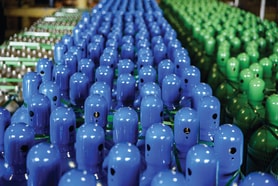Gases in the Glass Industry
With uses in a wide range of applications it’s crystal clear that the glass industry presents a significant drive for industrial gases. Yogender Malik looks at the areas for this demand and the role of gases in the glass industry.
The glass industry is divided into four major segments. The container glass segment produces glass packaging products, such as bottles and jars. The float glass segment produces windows for residential and commercial construction, automobile windshields, mirrors, instrumentation gauges, and furniture, such as tabletops and cabinet doors. The fibre glass segment is composed of two distinct sub industries: building insulation (glass wool); and textile fibres used to reinforce plastics and other materials for the transportation, marine, and construction industries. The specialty glass segment produces handmade glass, tableware and oven-ware, flat panel display glass, light bulbs, television tubes, fiber optics, and scientific and medical equipment.
The glass industry is one of the most energy intensive industries, in fact it is second only to the aluminum industry and consumes the second highest amount of energy to make a single unit or product. During the last several decades, glass manufacturers have worked to combat energy problems caused much in part by an extremely high-energy melting process. The melting and refining stages require around 8.6 million of the 12.98 million Btu (British thermal units) per tonne of glass produced. Glassmakers have come up with a variety of partial solutions, including increased insulation, improved refractory and furnace designs, and more efficient burners. Some manufacturers have even tried changing the fuel source by using oxygen instead of air in furnaces. Industrial gases have helped to ease the energy intensity of the glass industry, in terms of reducing cost, improving processes and enhancing product quality in recent years.
Oxygen
Oxy-fuel melting involves the replacement of the combustion air with oxygen. The elimination of nitrogen from the combustion atmosphere reduces the volume of the waste gases and the use of recuperator systems to preheat the oxygen supply to the burners is usually avoided. The reduction of waste gas volume (typically down to one-third) makes it possible to save furnace energy.
... to continue reading you must be subscribed









